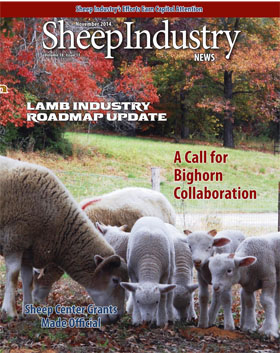Jewell’s Response to Bighorn Letter: Collaboration Needed
Secretary of Interior Sally Jewell responded to concerns and questions about plans for managing bighorn sheep and the impact on the American sheep industry with a letter to leading members of the U.S. House of Representatives and U.S. Senate.
It took nearly 90 days, but on Sept. 26 Jewell acknowledged the June 30 bi-partisan letter signed by 37 lawmakers and sent to herself and USDA Secretary Tom Vilsack.
In her response, Jewell agreed with the sheep industry that “more collaboration between interested and diverse stakeholders and experts would be extremely beneficial to help identify options for achieving domestic and bighorn sheep management objectives.”
She also pointed out some of the current land management practices.
“The Bureau of Land Management does not have to manage for zero risk to bighorn sheep from domestic sheep grazing, and the 2012 Western Association of Fish and Wildlife Agencies recommendations recognize that zero risk is ‘impossible’ to achieve,” Jewell’s letter, addressed to Kevin McCarthy, majority leader of the U.S. House of Representatives, states. Similar letters were sent each cosigner.
Jewell’s letter continued, “The BLM’s draft policy will provide guidance to BLM field offices to analyze and assess risk on a case-by-case basis, and to make informed decisions that minimize risk between bighorn sheep and domestic sheep and goat grazing, so that BLM can assist state and federal wildlife managers in their efforts to sustain bighorn sheep populations.”
U.S. Department of Agriculture Secretary Vilsack has yet to respond to the joint letter of Congress regarding the U.S. Forest Service’s plans, however, he did reply to a joint letter on the topic sent by the Governors of Idaho, Wyoming and Utah.
Vilsack’s letter, addressed to Idaho Gov. Butch Otter, stated that “grazing remains an appropriate and important use of National Forest System lands. The Forest Service understands the importance of balancing multiple use demands with management practices to support viable populations of bighorn sheep and a healthy domestic sheep industry.”
Vilsack noted that the Forest Service has instructed its line officers that best management practices to maintain separation need to be applied to the extent they are effective in supporting both uses.
“When a line officer determines that the potential risk for contact, as identified through the assessment process, is at an unacceptable level, the officer needs to identify and analyze potential replacement allotments when developing management alternatives,” Vilsack added.
Both letters can be found at www.sheepusa.org/IssuesPrograms_Issues_Bighorn.


